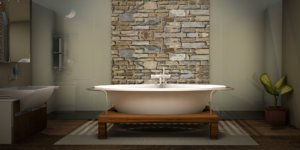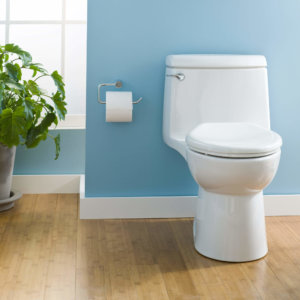How To Choose Between Fitted or Freestanding Bathtubs
If you’re considering getting a new bathtub, you may be wondering about the different types of tubs available. There are two major types of bathtubs: fitted and freestanding tubs. Keep reading to find out about the pros and cons of fitted and freestanding bathtubs so you can choose the right one for your bathroom.
What’s a Fitted Bathtub?
A fitted bathtub is one that a licensed contractor installs into your bathroom’s infrastructure. There are several types of fitted bathtubs, which include the following:
- Recessed bathtub: A recessed bathtub fits into a niche in your bathroom and is a popular choice for combined shower and bathtub models.
- Corner bathtub: A corner bathtub is usually triangular and fits into a corner of your bathroom, making it the most space-conserving tub model.
- Walk-in bathtub: A popular model for people with reduced mobility, this type of tub features a door built into the tub wall that allows you to enter the tub without stepping over the rim.
The Pros of a Fitted Bathtub
Here are some benefits of choosing a fitted bathtub:
- Efficient use of space: The key benefit of a fitted bathtub is the ability to fit it into bathrooms of all sizes and shapes. You can maximize your bathtub space by choosing a corner bathtub or a combined bathtub and shower, which eliminates the need for a separate shower stall.
- Accessibility: The bottom of a fitted bathtub is usually at or close to floor level, which makes it easier for people with limited mobility to get in and out. You can also add a door or bath bench to increase accessibility.
- Easy to integrate a shower: Because fitted bathtubs are integrated into a wall with plumbing, it’s often easy to add a shower feature to a tub that doesn’t come with one.
The Cons of a Fitted Bathtub
While fitted bathtubs are the most popular tub choice, they also have some limitations, such as the following:
- Requires expert installation: It’s usually a good idea to hire licensed contractors to install a fitted bathtub, so they can hook up the plumbing and seal the tub to prevent water damage.
- Limited customization options: You can change some of the surface features of a fitted tub, like the tiling or faucets, but there are only a few options when it comes to tub shapes or sizes.
- More difficult to replace: Because fitted bathtubs require expert installation, they’re also more difficult to replace if you want to put in a new tub.
What’s a Freestanding Bathtub?
A freestanding bathtub stands on your bathroom floor without being built into the wall. Here are some common types of freestanding bathtubs:
- Clawfoot tub: The oldest type of freestanding bathtub, clawfoot tubs stand on four feet, often shaped like claws. While you don’t have to secure these tubs, it’s a good idea to use either a screw or some type of glue to prevent them from moving when you use them.
- Pedestal tub: A pedestal tub sits on a weighted platform instead of standing on four feet and may require a stool to get in. Securing the tub using caulk or another adhesive ensures your safety when you use it.
- Soaking tub: These tubs usually have smaller floors and higher walls, making them ideal for sitting in. You may have to use a stool or steps to get into the tub.
The Pros of a Freestanding Bathtub
Here are some benefits of choosing a freestanding bathtub:
- Easy installation: As long as you’ve got the drainage hookup in the right place, you can simply carry the tub into your bathroom, secure it to the floor, and attach the faucet.
- Many aesthetic choices: Freestanding bathtubs come in all types of shapes and finishes, including the popular antique gilded look.
- Easy to replace: Because freestanding tubs are only attached to the floor, they’re easier to take out and replace with a new model.
The Cons of a Freestanding Bathtub
Here are some limitations of freestanding bathtubs:
- Less efficient use of space: Although you can place a freestanding bathtub wherever you want as long as the plumbing works, these tubs take up more space in your bathroom.
- Less accessible: You typically have to step over the tub’s rim to get in, which makes this type of tub more difficult for some people to use.
- Heavy weight: People sometimes think that freestanding tubs put less strain on your house’s structure, but when a freestanding tub is full of water, it can be just as heavy as a fitted tub. It’s a good idea to have your floor inspected to make sure it’s strong enough to hold the tub.
How To Choose Between a Fitted or Freestanding Bathtub
There are a few things to think about when you’re choosing between a fitted and freestanding bathtub. First, consider the space you have available. A fitted tub may utilize the space more efficiently if you have a smaller bathroom. However, if your bathroom is larger, you can consider a freestanding tub. It’s also important to think about the people using the tub. If you predict that you or your family members may need more accessibility now or in the next few years, then a fitted tub may be a better choice, especially if you consider a walk-in model.
If space and accessibility aren’t an issue, then you can choose your tub based on the design. Choosing a freestanding tub can create a vintage, timeless look to your bathroom, while fitted tubs may have more luxurious features, like jets and seating. Once you choose between a fitted or freestanding tub, you can research specific design models and shapes to find your perfect tub.
Here at the Allied Plumbing & Heating Supply Co., we have a wide selection of both fitted and freestanding tub models , perfect for contractors or DIY enthusiasts. We also have plumbing supplies to ensure your tub fits perfectly in your bathroom. Take a look at our inventory or contact us today.

